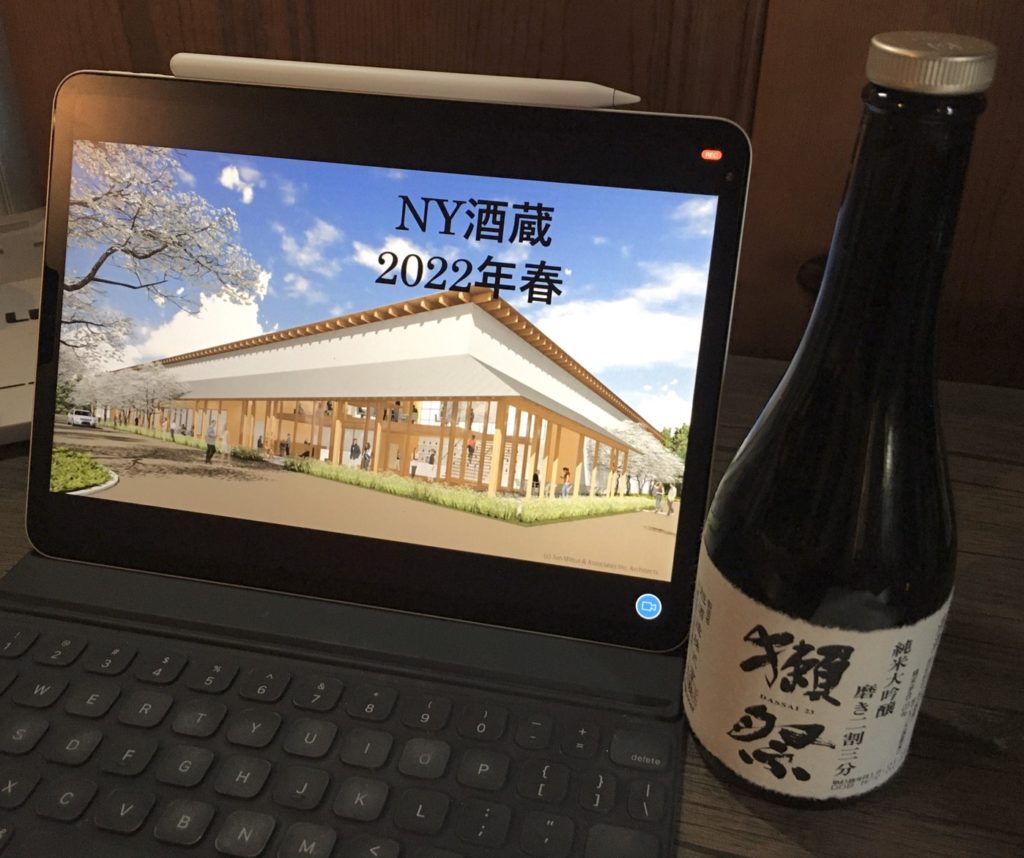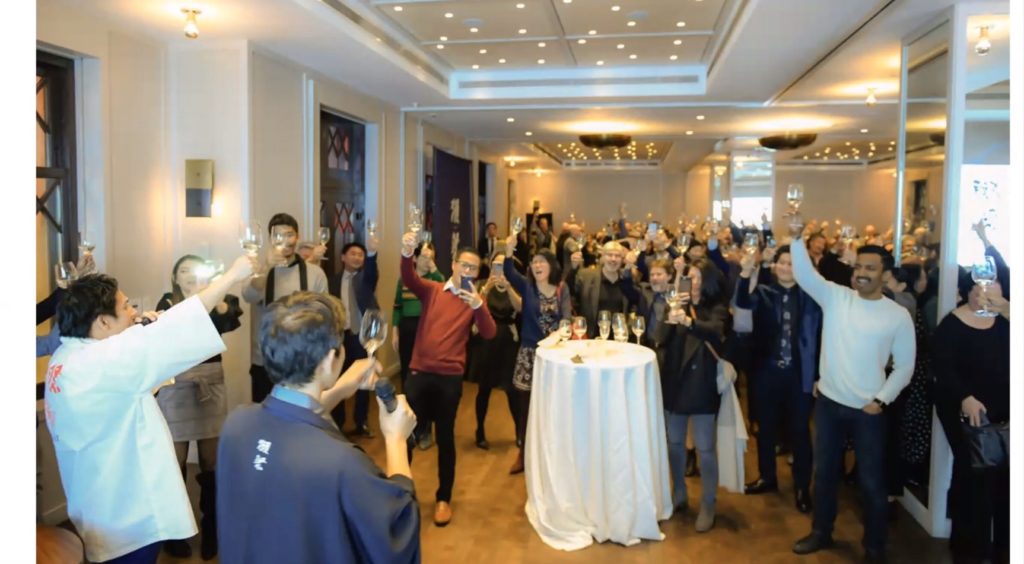
Written by Saki Kimura
“Dassai,” the sake brand from Asahi Shuzo in Yamaguchi Pref. has made a name for itself not only in Japan, but also in America, Asia, Europe, etc. There are many local fans who have been eagerly awaiting their new brewery in New York.
On the evening of May 21, 2020 (US time), Japanese travel agency HIS hosted an online event on the Zoom to hear Kazuhiro Sakurai, President of Asahi Brewery, talk about his company’s expansion into New York.
What brings them to New York? What is the difference between Japanese Dassai and the one here in the USA? How is COVID-19 affecting progress? Here’s a perfect report on the project of Dassai Blue, their new brand so far!
It was an offer from The Culinary Institute of America (CIA), the world’s leading culinary school, that led to their entry into New York. In order to enhance their sake course in the Japanese cuisine program, CIA proposed Dassai to build their new brewery that students could actually visit and learn the relationship between sake and food.
The new brewery will not only manufacture sake, but will be open for tours and has a liquor store with a tasting room. As HIS is also planning the brewery tour, it is expected to become a facility where local people and tourists can easily visit and experience the sake culture.
Last October, they announced that the brand name was “Dassai Blue.” As the Japanese proverb says, “blue dye comes from the indigo plant and is bluer than indigo (the student has become the master),” its name shows its goal to surpass the existing Dassai. Sakurai explains, “But of course, the existing Dassai aims for better sake than Dassai Blue.”
The facility will be built on the site of a previously owned supermarket in Hyde Park, New York; about a five-minute walk from the CIA campus. This area has a source that supplies water to Manhattan; the heart of New York City. President Sakurai says, “The water is very tasty.”
Asahi Shuzo still focuses on Yamadanishiki as the raw material rice and is currently trying to grow it locally under contract with an Arkansas farmer. However, in the early stages, they will also use Yamadanishiki imported from Japan. “Farmers are still experimenting – we don’t know if they can produce a high quality Yamadanishiki. We hope the amount of American Yamadanishiki will gradually increase while using Japanese rice.“

Asahi Shuzo’s overseas exports in 2019 was 3.4 billion JPY. This is about 15% of Japan’s sake exports of 23.4 billion JPY. While he is proud to say that “Dassai the best-known brand overseas,” President Sakurai’s eyes are calmly focused on the current situation of sake in the world.
“Those of you who are in Japan may have heard that sake became a boom overseas. But from the perspective of those of you in the U.S., it’s not correct. You can find sake in Japanese restaurants, but can’t find it on the shelves of ordinary restaurants or even in supermarkets that sell good natural foods,” President Sakurai speaks to participants from both Japan and the United States. “We think that’s an issue, and are struggling to solve it.”
In April 2018, they opened the restaurant Dassaï Joël Robuchon in Paris in collaboration with the late French master Joël Robuchon. The aim is to break the stereotype that “sake can only be drunk with Japanese food,” and to make those who are still unfamiliar with sake aware of its appeal.
“At the moment, only customers who are interested in Japanese culture and food are enjoying our sake. When people come to the restaurant, on the other hand, we can give the opportunity to try our sake to those who just want to eat Robuchon’s food or who want to eat good French food, which is very important.”
Dassai’s goal is to build a food culture with sake in every corner of the world. One of these efforts is the New York’s sake brewery project.
The project was originally scheduled to be operational in 2019, but struggled with state permits and “American-ish” business practices in the construction and design process. In particular, as the construction of the sake brewery is a first for a local design and construction company, it is taking more time than expected.
“In the U.S., lawyers and consultants are very strong. When the construction work has progressed to a certain extent, lawyers and consultants emerge. We have to cross that hurdle to move forward.”
Then, in March 2020, New York State implemented a lockdown due to the COVID-19. Asahi Shuzo was also forced to take a break from construction.
“New York is also on the recovery path, but logistics, permits, and gathering workers is still difficult to do. If you go overboard at this point, it will never go well and we’ll end up with higher construction costs and a longer construction period. There are no restaurants open, so there is no place to sell our products even if we proceed now. We took the plunge and to stop the construction until everything would recover.”
In response to this situation, the construction period was extended from six months to a year. The plan is currently underway with the goal of starting operations in the spring of 2022.

In addition to the questions gathered in advance, President Sakurai answered questions posted by the participants in the comments section on Zoom. When asked about the distribution price in the U.S. “Can we get the same price as Japanese Dassai?,” he replied “We don’t know yet. It might be a little difficult.”
“America is a country where labor costs are very high. We’re going to aim for the edge, but we don’t know if it’s still going to be higher or the same as Japanese one.”
This was followed by the question, “What are you tinkering with in your marketing around the world?” In the course of its global expansion, Dassai sometimes receives requests to make “sake that tastes like wine in Europe,” “dry areas prefer a richer flavor,” “a product that is cheaper but more upscale looking,” etc. While understanding the differences in preferences between countries he says, “We try not to think too much about each area.”
“In any case, we have a selfish desire to make sake that we think is delicious all over the world. As sake is an article of taste, we should be able to find people that have the same taste if we keep sticking to our guns. We place importance on explaining things properly without changing the product.”
What kind of taste does President Sakurai think delicious? The answer is, “There is a beautiful scent like fresh fruit in a flash, the sweetness spreads in the mouth along with the scent, and it disappears cleanly.”
“However, the Dassai you’ll drink next should be different from that you drank before, tastier than the previous one. As it evolves in this way, the taste that I think is “delicious” may change as well.”
More than 100 fans from the US and Japan participated in this online event. At the end of the event, all participants unmuted and applauded. “Good luck!” “Thank you.” “Looking forward to it!” – To many cheers, “I’m moved that people from all over the world have come together at such a difficult time,” said President Sakurai, cracking a smile.
In the face of the COVID-19 situation and other difficulties, Asahi Shuzo is full of calm enthusiasm to breathe new life into the global sake market. We can’t wait to see a glass of Dassai Blue to taste in 2022!